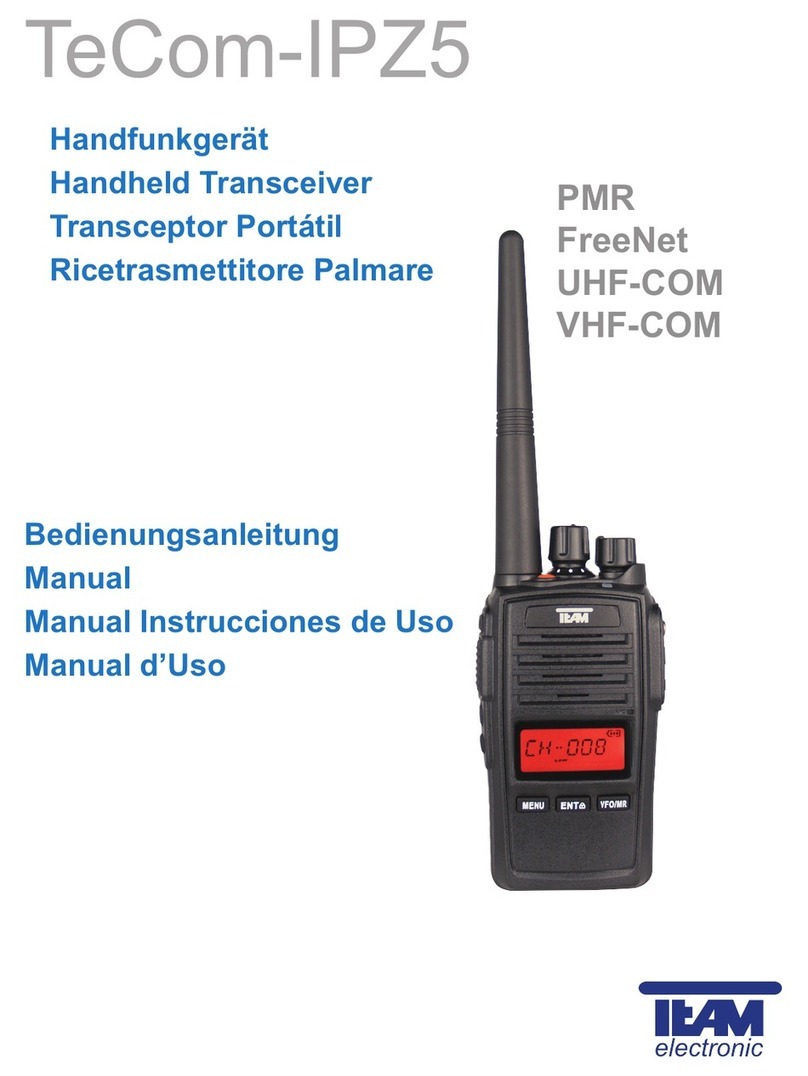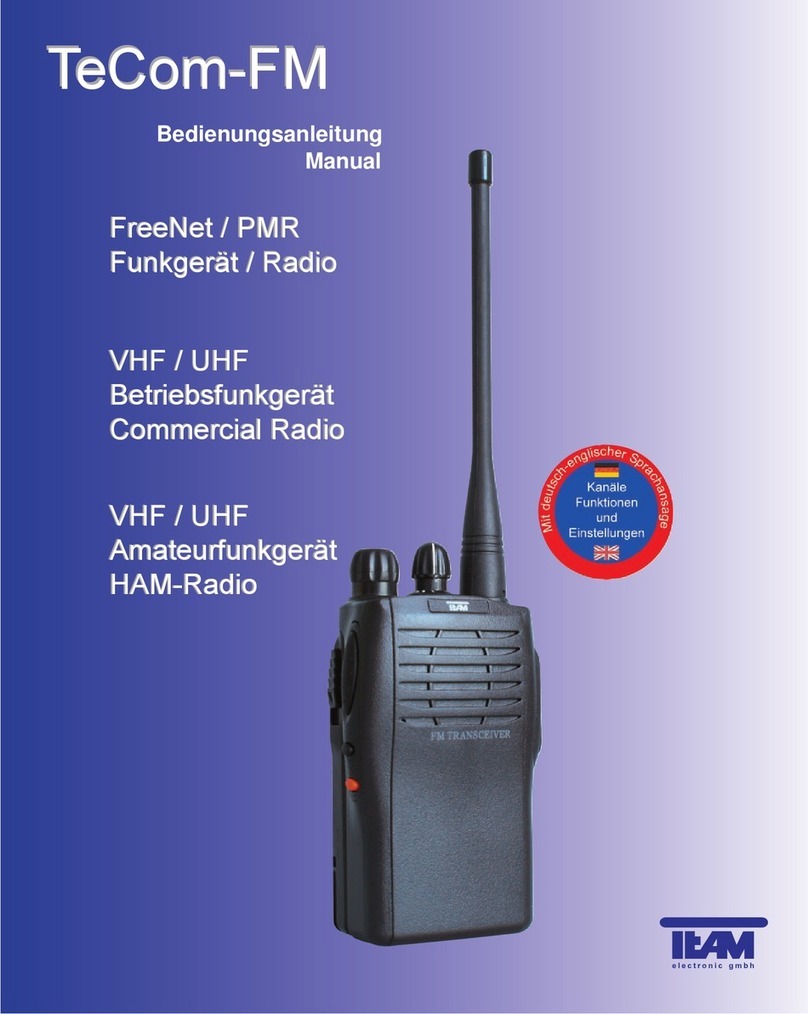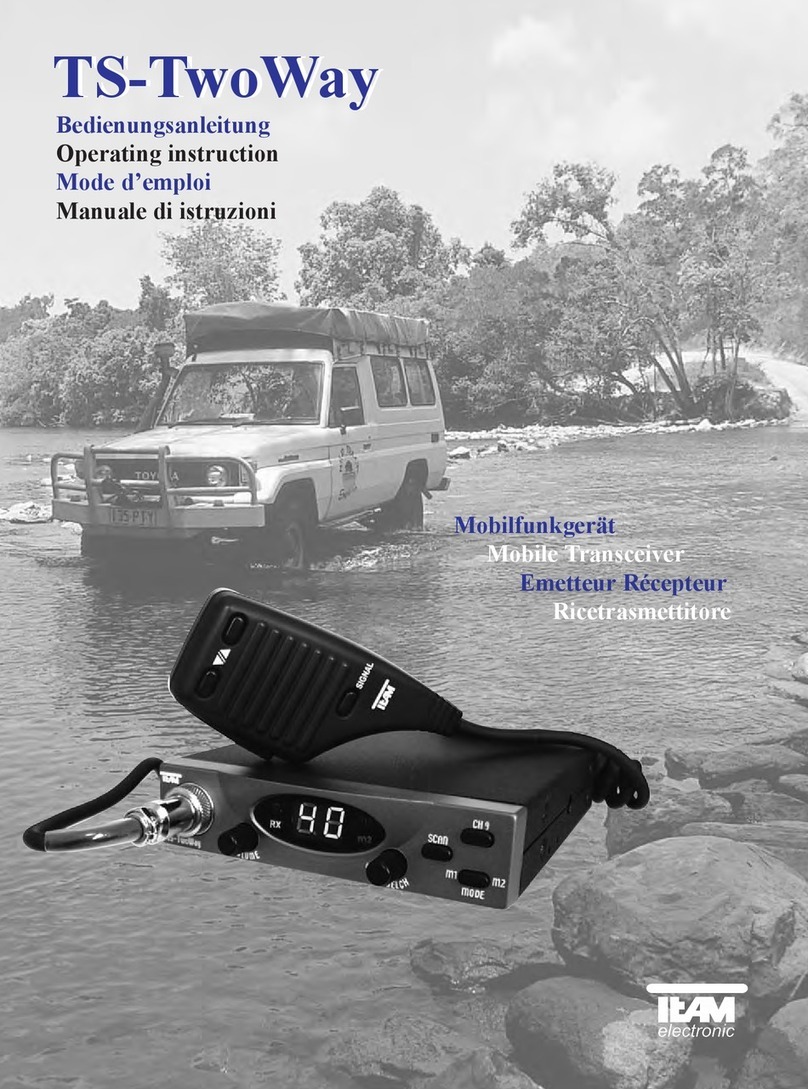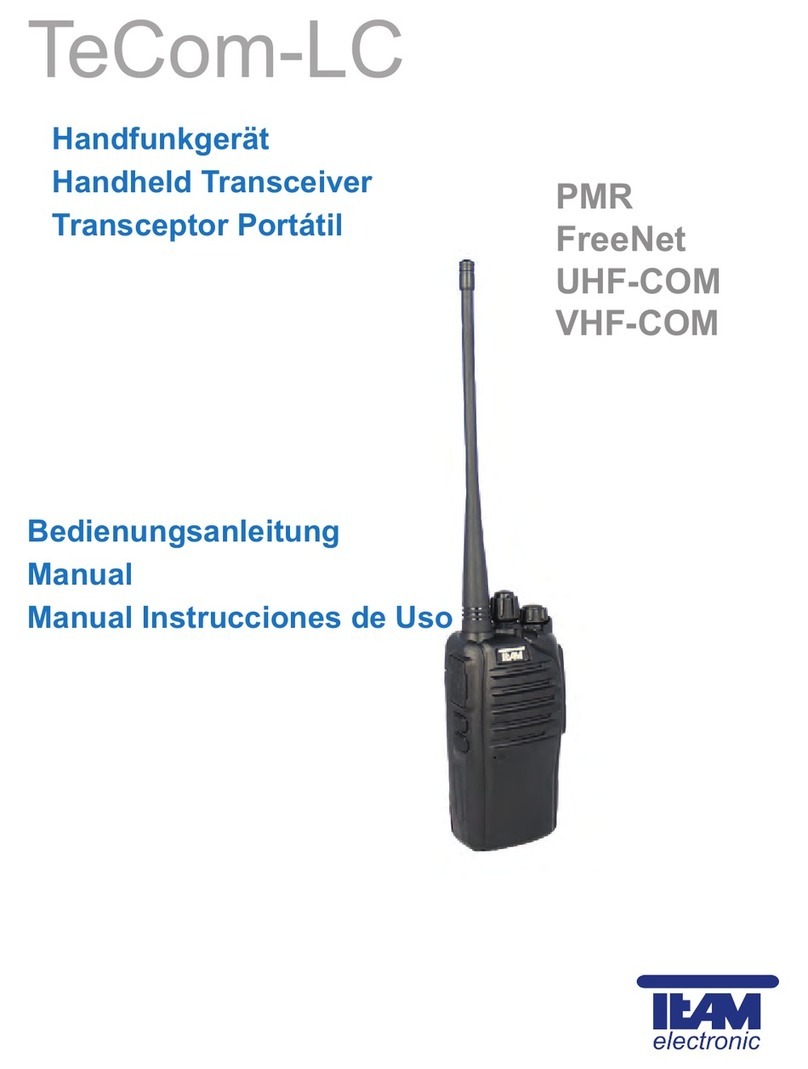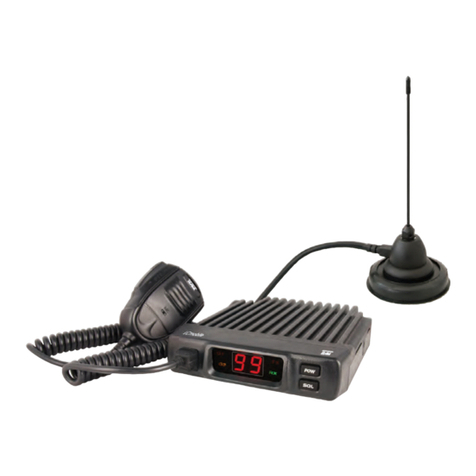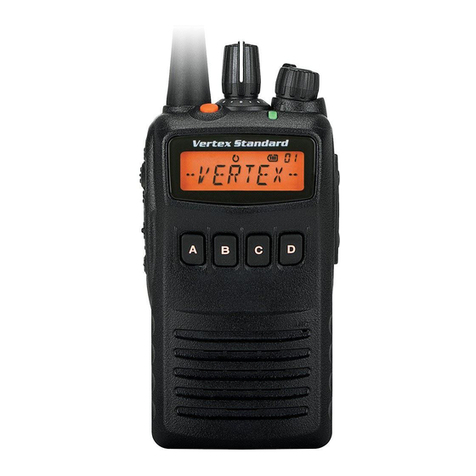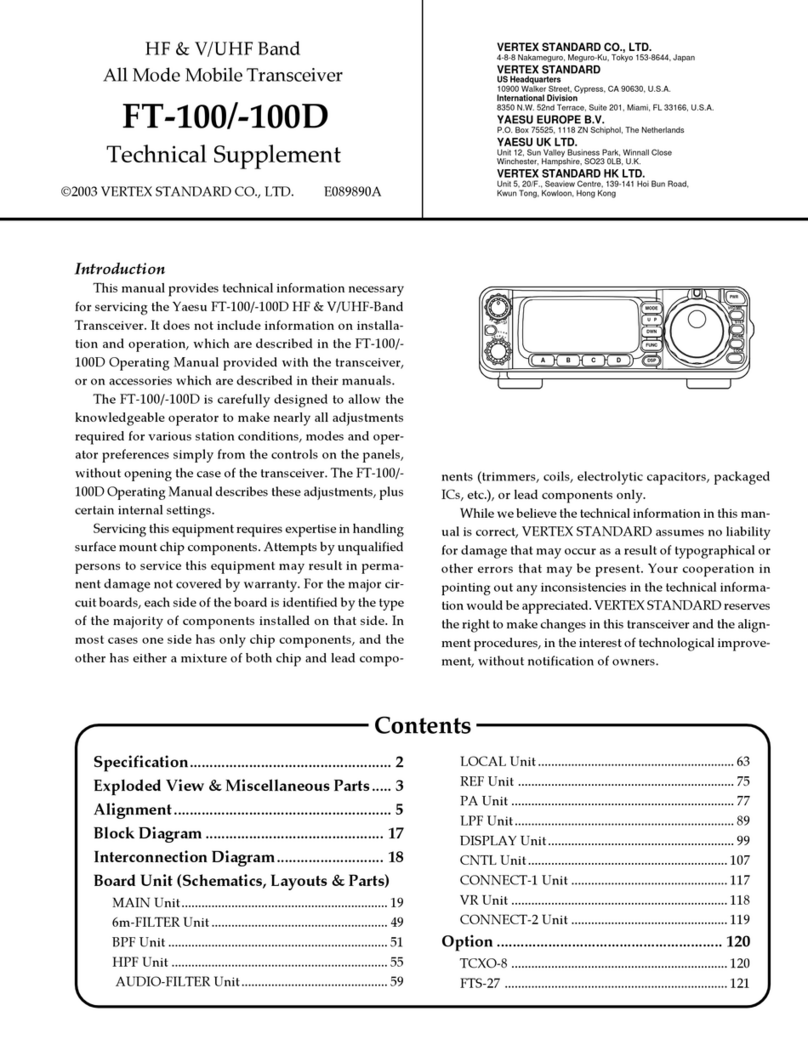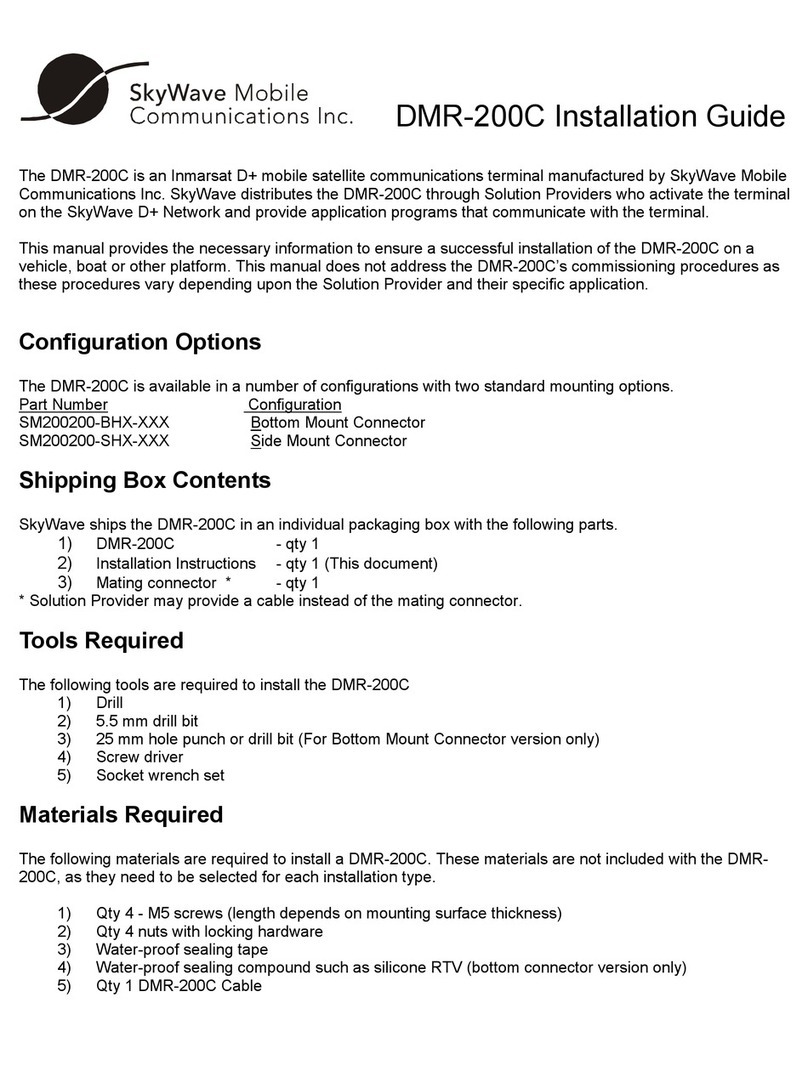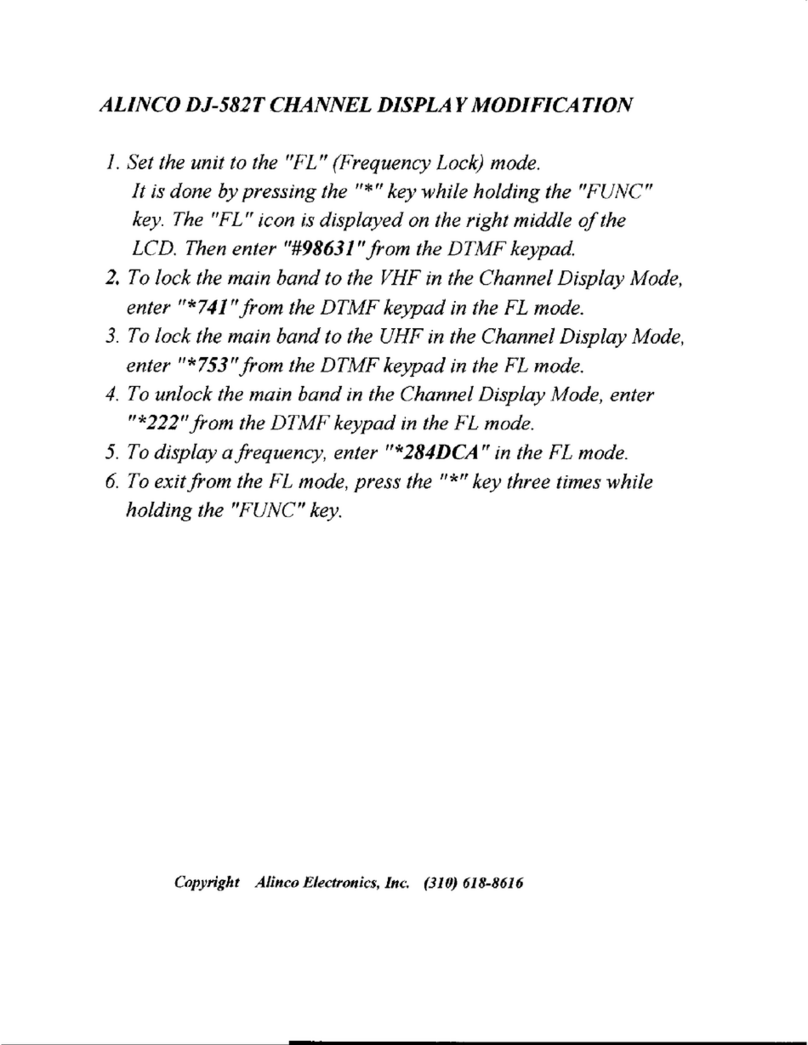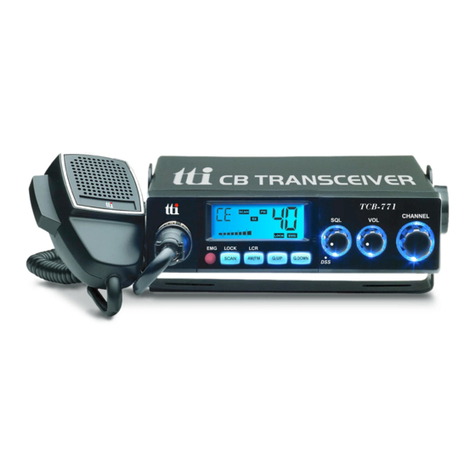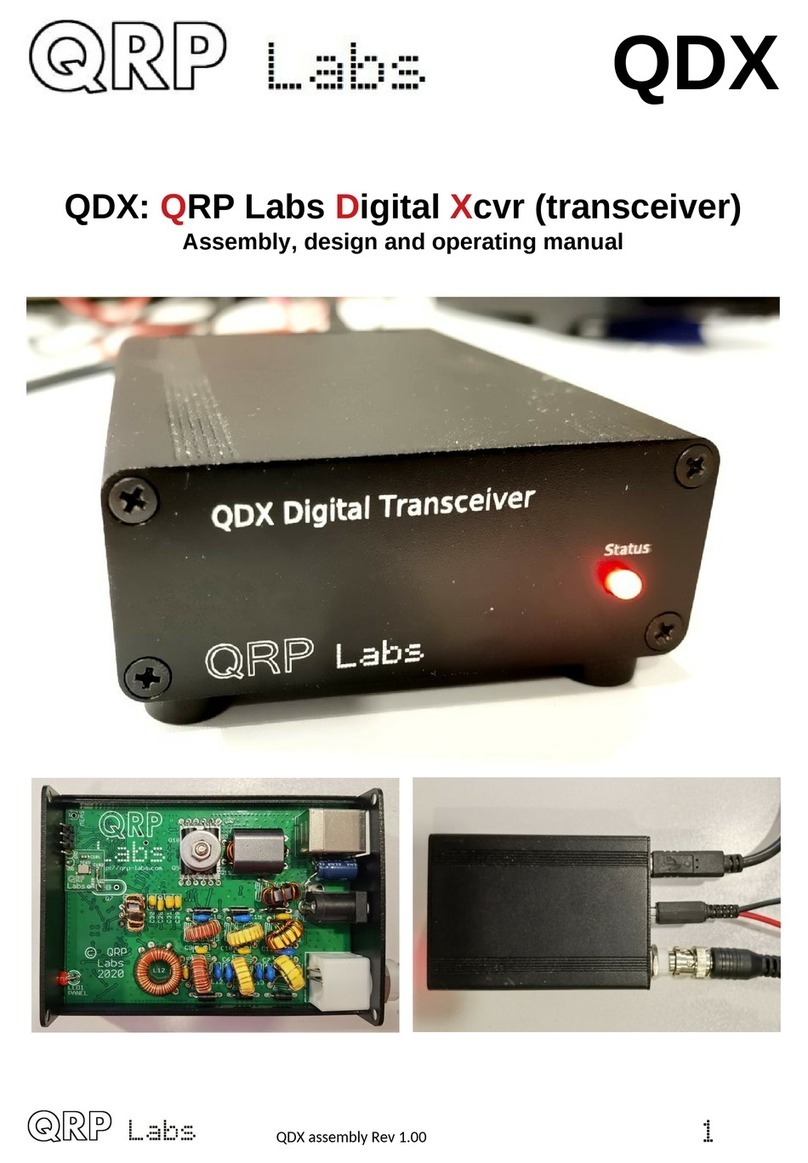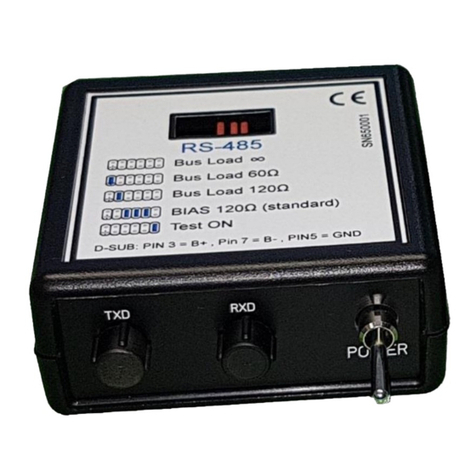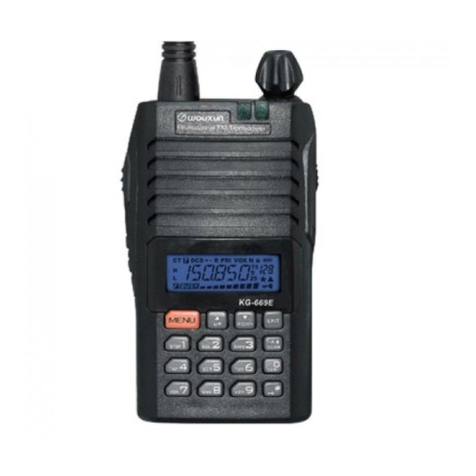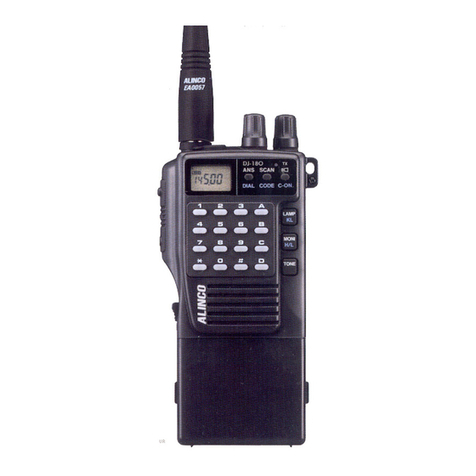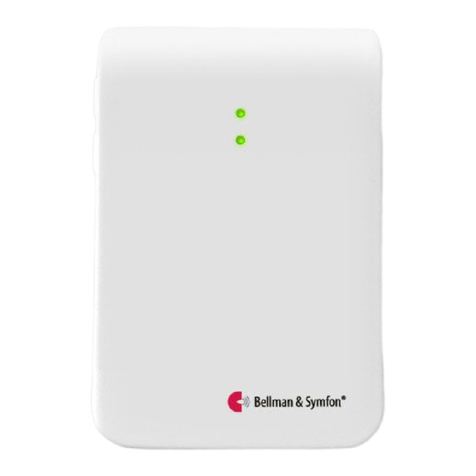Team PT-6200 Assembly instructions

For sale and use in :
A, B, CH, CZ, D, DK, E, F,
FIN, GB, HR, I, L, N, NL, S
PT-6200 UHF / VHF
Handfunkgerät
Handheld Transceiver
Portofoon
Bedienungsanleitung
Handleiding
Manual
TEAM Electronic GmbH
Bolongarostrasse 88; D-65929 Frankfurt am Main, Germany
phone ++49 / 69 / 300 950 0 - fax ++49 / 69 / 31 43 82
WEEE - Reg. Nr. DE 91930360 8 ( EAR ), 50635 ( ERA )
GRS-Nr. 10001374
DSD 2617305, ARA 2284
pt-6200.qxp 03.05.2006 14:11 Seite 1

20 21
Dear Customer,
we thank you for the purchase of the PT-6200. Please read this instruc-
tion manual carefully before using the PT-6200. You will learn about the
different features and functions of your new handheld transceiver.
The use of commercial frequencies requires a licence. For more informa-
tion about the regulations see the passport of the PT-6200.
We recommend, to get the radio programmed by an authorized TEAM
dealer. The radio has to be set according to the restrictions of the individ-
ual licence of the user.
SAFETY
It is important that the user is aware of and understands hazards common
to the operation of any transceivers.
WARNING!
Turn off your transceiver prior to entering any area with a potentially explo-
sive atmosphere (where the air contains gas, dust and smog, etc.), such
as while taking on fuel, or while parking at a gasoline service station.
PRECAUTIONS IN USE
Please comply with the following attentions to avoid fire, bodily injury and
damage to the transceiver. The transceiver is recommended to transmit
for 1 minute and receive for 4 minutes. Long time transmitting or continu-
ous working in high power mode will make the rear side of the transceiv-
er generate heat.
Please don't disassemble or assemble the transceiver under any circum-
stances.
Please don't expose the transceiver to direct sunlight for a long time; don't
place the transceiver near any heating devices, either.
Please don't put the transceiver in extremely dusty, moist or dabbling
places; don't place it on unstable surfaces, either.
If the transceiver emits smoke or strange odors, turn it ff and remove the
battery from the transceiver and promptly contact your local authorized
TEAM Electronic dealer.
CONTENTS page
1 Unpacking and Checking 22
1.1 Supplied Accessories 22
2 Preparation 22
2.1 Battery Info 22 - 24
2.2 Battery Care Tips 24 - 25
2.3 Battery Recycling and Disposing 25
2.4 Charging the Battery 25
3 Accessories 26
3.1 Installing/Removing the Battery Pack 26
3.2 Installing the Antenna 26
3.3 Installing the Belt Clip 26
3.4 Installing the Dust Cover over the Versatile Connector 26
3.5 Installing the Optional speaker/Microphone 26
4 Getting Acquainted 27
4.1 Radio Overview 27
5 Basic Operation 28
6 Programmable Buttons 28
6.1 Automatic Dialing 28
6.2 Key Lock 29
6.3 Monitor/Cancel Squelch 29
6.4 Scan 29 - 30
6.5 Priority Scan 30
6.6 Temporarily Delete 30
6.7 CALL1/CALL2 30
7 VOX 30 - 31
8 Clone Mode 31
9 Emergency Alert 31
10 Auxiliary Functions 31
10.1 Time-out Timer (TOT) 31
10.2 Battery Saving 32
10.3 Low Battery Warning 32
10.4 Voice Annunciation of Channel Number 32
10.5 Busy Channel Lockout (BCL) 32
10.6 Remote Kill 32
10.7 CTCSS/DCS 32
10.8 DTMF 33
10.9 KDC 1200 Signaling 33
10.10 5 Tone Signaling 33 - 34
10.11 Transmitting Beginning/Ending Signaling 34
11 Troubleshooting 34
12 Technical Specifications 35
13 Settings (by the dealer) 36
14 Notes 36
Accessories 54 -55
GB GB
pt-6200.qxp 03.05.2006 14:11 Seite 21

22 23
1 UNPACKING AND CHECKING
Unpack the transceiver carefully. We recommend that you identify the
items listed in the following table before discarding the packing mate-
rial. If any items are missing or have been damaged during shipment,
please contact the dealer immediately.
1.1 Supplied Accessories
1 x Antenna 1 x Belt clip 1 x Dust cover
1 x Screw 1 x Battery 1 x Charger
1 x Power adapter 1 x User's Manual 1 x Hand strap
2 PREPARATION
2.1 Battery Info
Battery Precautions
CAUTION
1) Do not recharge the battery pack if it is already fully charged. Doing
so may cause the life of the battery pack to shorten or the battery
pack may be damaged.
2) After recharging the battery pack, disconnect it from the charger. If
the charger power is reset (turned ON after being turned OFF),
recharging will start again and the battery pack will become over-
charged.
3) Do not use the transceiver while charging the battery pack. We re-
commend you switch the transceiver power OFF while in charging.
4) Do not short the battery terminals or dispose of the battery by fire.
5) Never attempt to remove the casing from the battery pack.
DANGER!
1) Do not disassemble or reconstruct battery!
The battery pack has a safety function and protection circuit to avoid
danger. If they suffer serious damage, the battery may generate
heat or smoke, rupture, or burst into flame.
2) Do not short-circuit the battery!
Do not join the + and - terminals using any form of metal (such as a
paperclip or wire). Do not carry or store the battery pack in contain-
ers holding metal objects (such as wires, chain-necklace or hair-
pins). If the battery pack is short-circuited, excessive current will
flow and the battery may generate heat or smoke, rupture, or burst
into flame. It will also cause metal object to heat up.
3) Do not incinerate or apply heat the battery!
If the insulator is melted, the gas release vent or safety function is
damaged, or the electrolyte is ignited, the battery may generate heat
or smoke, rupture, or burst into flame.
4) Do not use or leave the battery near fires, stoves, or other heat gene
rators!
If the polymer separator is melted due to high temperature, an inter-
nal short-circuit may occur in the individual cells and the battery may
generate heat or smoke, rupture, or burst into flame.
5) Do not immerse the battery in water or get it wet by other means!
If the battery's protection circuit is damaged, the battery may charge
at extreme current (or voltage) and an abnormal chemical reaction
may occur. The battery may generate heat or smoke, rupture, or burst
into flame.
6) Do not charge the battery near fires or under direct sunlight!
If the battery's protection circuit is damaged, the battery may charge
at extreme current (or voltage) and an abnormal chemical reaction
may occur. The battery may generate heat or smoke, rupture, or burst
into flame.
7) Use only the specified charger and observe charging requirements!
If the battery is charged in unspecified conditions (under high temper-
ature over the regulated value, excessive high voltage or current over
regulated value, or with a remodeled charger), it may overcharge or
an abnormal chemical reaction may occur. The battery may generate
heat or smoke, or burst into flame.
8) Do not pierce the battery with any object, strike with an instrument, or
step on it!
This may break or deform the battery, causing a shortcircuited. The
battery may generate heat or smoke, rupture, or burst into flame.
9) Do not jar or throw the battery!
An impact may cause the battery to leak, generate heat or smoke,
rupture, and/or burst into flame. If the battery's protection circuit is
damaged, the battery may charge at an abnormal current (or voltage),
and an abnormal chemical reaction may occur. The battery may gen-
erate heat or smoke, rupture, or burst into flame.
10) Do not use the battery pack if it is damaged in any way!
The battery may generate heat or smoke, rupture, or burst into flame.
11) Do not solder directly onto the battery!
If the insulator is melted or the gas release vent or safety function is
damaged, the battery may generate heat or smoke, rupture, or burst
into flame.
12) Do not reverse the battery polarity (and terminals)!
When charging a reversed battery, an abnormal chemical reaction
may occur. In some cases, an unexpected large amount of current
may flow upon discharging. The battery may generate heat or smoke,
rupture, or burst into flame.
13) Do not reverse-charge or reverse-connect the battery!
The battery pack has positive and negative poles. If the battery pack
does not smoothly connect with a charger or operating equipment, do
not force it; check the polarity of the battery. If the battery pack is
GB GB
pt-6200.qxp 03.05.2006 14:11 Seite 23

24 25
reverse-connected to the charger, it will be reverse-charged and an
abnormal chemical reaction may occur. The battery may generate
heat or smoke, rupture, or burst into flame.
14) Do not touch a ruptured and leaking battery!
If the electrolyte liquid from the battery gets into your eyes, wash your
eyes out with fresh water as soon as possible, without rubbing your
eyes. Go to the hospital immediately. If left untreated, it may cause
eye-problems.
WARNING
1) Do not charge the battery for longer than the specified time!
If the battery pack has not finished charging even after the regulat-
ed time has passed, stop it. The battery may generate heat or
smoke, rupture, or burst into flame.
2) Do not place the battery pack into a microwave or highpressure
container!
The battery may generate heat or smoke, rupture, or burst into
flame.
3) Keep ruptured and leaking battery packs away from fire!
If the battery pack is leaking (or the battery emits a bad odor),
immediately remove it from flammable areas. Electrolyte leaking
from battery can easily catch on fire and cause the battery to gen-
erate smoke or burst into flame.
4) Do not use an abnormal battery!
If the battery pack emits a bad odor, appears to have different color-
ing, is deformed, or seems abnormal for any other reason, remove it
from the charger or operating equipment and do not use it. The bat-
tery may generate heat or smoke, rupture, or burst into flame.
2.2 Battery Care Tips
The transceiver is equipped with a TEAM Ni-MH battery pack. An
optional Li-ion battery pack is available. The following tips help you to
get the best battery performance and longest battery life.
1) Charge the new battery pack continuously for 4~7 hours before its
initial using, which ensures the maximum battery capacity and best
performance in using.
2) Charging the battery pack in non-TEAM equipment will cause
battery damage and the battery warranty invalid.
3) The battery pack can be charged while in the transceiver, and to
ensure it is fully charged it's recommended to charge the battery
pack with the transceiver turned off.
4) The ideal temperature to store the battery pack is 25 (room tem-
perature). Charging the battery pack at a low temperature (below 0 )
will cause electrolyte leakage and damage to the battery pack.
5) Charging the battery pack at a high temperature (above 35 ) will
cause decrease in battery discharge capacity and affect the trans-
ceiver performance. The TEAM SLG-PT6200 rapid charger has a
temperature sensor, which ensures the battery is charged within
the temperature range mentioned above.
6) A new battery shows no significant life shortening even after two-
year storage. The new or used battery should be stored in a cool
and dry place.
7) If recharge the battery pack after long storage, you should charge it
continuously for 4~7 hours.
8) Do not leave the transceiver and battery in the charger when not
charging. Overlong charging will shorten the battery life. (Please do
not use the charger as the transceiver's mounting bracket.)
9) Please use the TEAM SLG-PT6200 charger to ensure battery
normal work and prolong its life. The battery and charger are design-
ed under an integrated concept of power system.
2.3 Battery Recycling and Disposing
After the battery life expires, the Li-ion battery can be recycled, how-
ever, the recycling facilities are not available everywhere. TEAM goes
in for the recycling of all the rechargeable batteries. For more details
please contact your local TEAM distributor.
2.4 Charging the Battery
Anew battery, or a battery the power of which appears low power indi-
cator displays one bar or no bar, needs charging before using.
Red The battery is in the state of charging.
Green The battery is fully charged or the charger is not
not connected with the battery.
Flashing red Ready for charging.
Yellow The battery temperature is abnormal.
Dim The battery is damaged and unable tobe charged.
1) Connect the power adapter with the bat-
tery charger. Plug the adapter into an AC
wall outlet and the indicator turns green.
2) Place the battery or transceiver into the
charger slot. The indicator turns red or
flashes, then the charger gets in the state of
charging automatically. Charging time
depends on battery capacity. When battery
is fully charged the indicator turns green.
Notes:
1) The battery is not fully charged in the factory, and probably
the new battery is falsely indicated as full charge. Before the initial
use, please charge the new battery continuously for 4~7 hours.
2) The charger will stop charging and the indicator turns yellow
if the charger detects the battery is damaged or if the temperature
of the battery is too high (higher than 50 for Ni-MH battery or 40 for
Li-ion battery).
3) Do not charge the battery longer than the specified time. And do
not charge the battery again if it is charged fully, otherwise, its life
will be shortened or it will be damaged.
GB GB
pt-6200.qxp 03.05.2006 14:11 Seite 25

26 27
3 Accessories
3.1 Installing/Removing the Battery Pack
To install the battery pack:
1) Match the 3 bulges of the battery pack with the
corresponding holes at the rear bottom of the
transceiver;
2) Then firmly press the battery pack downwards
to lock it in place until a click is heard.
To remove the battery pack:
1) Use your thumb to press the belt clip, and one side
of your index finger to press the release button;
2) And then pull the battery away from the transceiver.
Screw the antenna into the connector at the top of
the transceiver by holding the bottom of the antenna
and turn it clockwise until secure. Match the
grooves of the belt clip with those on the rear of the
battery. Then press the support belt clip downwards
to lock it in place.
3.2 Installing the Antenna
Screw the antenna into the connector at the top of the transceiv-
er by holding the bottom of the antenna and turn it clockwise
until secure. Match the grooves of the belt clip with those on the
rear of the battery. Then press the support belt clip downwards
to lock it in place.
3.3 Installing the Belt Clip
Match the grooves of the belt clip with those on the
rear of the battery. Then press the support belt clip
downwards to lock it in place.
3.4 Installing the Dust Cover over the Versatile Connector
When not using the optional Speaker/Microphone, install
the dust cover over the versatile connector with the sup-
plied screw.
3.5 Installing the Optional Speaker / Microphone
Insert the Speaker / Microphone plug into the jacks of the versatile
connector, and fix it with the supplied snail screw.
Notes:
Only use the original TEAM accessories for the PT-
6200.
Optional accessories, e.g. ear- / microphone, are not
included in the scope of delivery.
4 GETTING ACQUAINTED
4.1 Radio Overview
1 Antenna
2 LED Indicator
> Lights red while transmitting;
> Lights green while receiving a signal.
> Flashes orange while receiving DTMF, KDC1200 and 5 Tone
signaling identical with the local setting.
> Flashes red while in low battery power.
3 Channel Selector
Rotate to select channel 1-16.
4 Power/Volume Switch
Turn clockwise to switch on the radio. Turn counterclockwise till a
click is heard to switch off the radio. Rotate to adjust the volume
after turning on the radio.
5 Side Button 1
Programmable function button: Press it to activate the preset auxil-
iary function. Its default setting is scanning.
6 PTT (Push-to-talk)
To make a call, press and hold the PTT button, then speak into the
microphone with normal voice. Release the PTT button to receive.
7 Side Button 2
Programmable function button: Press it to activate the preset auxil-
iary function. Its default setting is canceling squelch.
8 Emergency Button
Press and hold it longer than the preset time to activate emergency
alert function.
9 Microphone/Speaker Jacks
For connecting external Microphone/Speaker.
GB GB
pt-6200.qxp 03.05.2006 14:11 Seite 27

28 29
5 Basic Operation
Switch On
Switch on the radio by turning the Power/Volume switch clockwise
until a click is heard, then the radio will be in the state of stand by and
you will hear a beep if the dealer has set it.
Adjust Volume
Press the button preset as monitoring or canceling squelch to listen to
the background noise and rotate the Power/Volume switch to adjust
volume.
Select a Channel
For setting the channel 1 - 16, rotate the channel selector. You will
hear voice from the speaker while receiving proper signals.
Make a Call
To make a call, press PTT, and speak in normal voice and please keep
your mouth 1~2 inches away from the microphone.
Receive a Call
Release the PTT button to receive a call. Your dealer can set CTCSS,
DCS, DTMF, KDC1200 and 5 Tone signaling on you radio channels by
PC software. If you select a channel that has been preset with the tone
signaling, you will not hear any other calls except those from your own
system.
6 Programmable Buttons
The dealer can program the Side Button 1 and Side Button 2 as one
of the following auxiliary functions.
> None (No Function)
> Automatic Dialing
> Key Lock
> Key Lock and Backup
> Instantaneously Monitor
> Scan
> Scan + Temporarily Delete
> Cancel Squelch
> Instantaneously Cancel Squelch
> Temporarily Delete
> CALL 1
> CALL 2
6.1 Automatic Dialing
Press and hold the PTT button, and press the side button that has
been set as automatic dialing to transmit the stored DTMF code.
Release the automatic dialing button and then speak to the micro-
phone with the PTT button still pressed.
6.2 Key Lock
1) Press and hold the side button set as key lock for 1 second to acti-
vate or inactivate key lock. While Key Lock is active, the following
keys are locked:
Channel Selector, Scan button, Scan + Temporarily Delete button,
Temporarily Delete button.
2) If the side button has been set as Key Lock and Backup, Key Lock
will remain active after the radio is turned off and turned on again. If
Backup function has not been set, Key Lock will be canceled after
turning on the radio again.
6.3 Monitor/Cancel Squelch
Monitor, Instantaneously Monitor, Cancel Squelch, and Instantaneous-
ly Cancel Squelch functions can enable you to listen to the signals
unable be heard while in normal operations, r can be used to adjust
the selected channel's volume.
Monitor:
Press the monitor button once to turn off CTCSS, DCS, DTMF,
KDC1200, and 5 Tone signaling, and press it again to return to normal
operation.
Instantaneously Monitor:
Press and hold the monitor button to turn off CTCSS, DCS, DTMF,
KDC1200, and 5 Tone signaling, and release it to return to normal ope-
ration.
Cancel Squelch:
Press the button once to listen to background noise, and press it again
to return to normal operation. Instantaneously Cancel Squelch: Press
and hold the button to listen to background noise, and release it to
return to normal operation.
6.4 Scan
While in scanning, the radio checks every channel and stops on the
channel on which a signal is detected until that signal disappears. If
the delay time between signal disappearing and continuing scanning
has been preset, the radio will remain on that channel in the delay time
even receiving any signals at that time. Only when there are two chan-
nels added in the scan list and the scan function has been activated,
the radio can start scanning.
1) Press the button set as Scan or Scan + Temporarily Delete to start
scanning.
2) The radio will start scanning from the current channel and scan
channel one by one in the consequence of channel No. and the LED
flashes green.
3) When a signal is detected on a channel ( DTMF, KDC1200, and
5-Tone signaling is off while scanning), scanning pauses and LED
lights green.
GB GB
pt-6200.qxp 03.05.2006 14:11 Seite 29

30 31
4) You can select a channel to make a call by pressing the PTT button
during anytime of scanning.
5) Press again the button set as Scan or Scan + Temporarily Delete to
end scanning.
6.5 Priority Scan
During scanning, if the priority channel has been set on the radio,
when the priority channel receives a signal the radio will automatical-
ly switch to the priority channel even the normal channel is receiving
signals at that time. And the radio will stay on the priority channel till
that signal disappears. The dealer can set the delay time between sig-
nal disappearing and continuing scanning.
6.6 Temporarily Delete
When scanning pauses on a channel, press and hold the button pro-
grammed as Temporarily Delete or Scan + Temporarily Delete for
1 second to delete this channel temporarily from the scanning list.
Note:
The priority channel cannot be deleted.And when the number of scan-
ning channels is less than 2, you cannot delete any channel, either.
After exiting scanning mode and entering it again, the temporarily
deleted channel will be added in the scanning list again.
6.7 CALL1/CALL2
Press and hold the PTT button, and then press the side button pro-
grammed as CALL1 or CALL2 to send the stored 5Tone code.
Release CALL1 or CALL2 button, and speak to the microphone to call
with the PTT button still pressed.
7 VOX
VOX function enables you to use the radio without manual operation.
This function can only be set by the dealer and you a specified ear- /
microphone as to be connected to the radio.
Before using VOX, you must set VOX gain level. Such setting enables
the radio to identify the voice volume. If the microphone is too sensi-
tive, the background noise will trigger the radio to transmit. If the
microphone is not sensitive enough, it cannot receive your voice when
you speak. Make sure to adjust VOX gain level to proper sensitivity.
1) Connect the ear- / microphone with the radio.
2) Turn off the radio. Then, turn it back on, while pressing Side Button
1 at the same time.
3) Hold Side Button 1 till a beep sounds and LED lights orange. Then,
release Side Button 1, and the radio will announce VOX gain level.
4) Press Side Button 1 to increase VOX gain level; press Side Button 2
to decrease it.
VOX gain level can be adjusted between level 1 and level 10 and
OFF. When adjusting gain level, the radio will announce VOX gain
level. If OFF is selected, beep tone will sound.
5) Press PTT to store the setting. After a beep, the radio announces
new VOX gain level.
6) Turn off the radio, and turn it on again, and then VOX function is
activated.
8 Clone Mode
The dealer can turn on or turn off this function by programming. You
can transmit set-up data to or from another radio. Press the PTT but-
ton and Side Button 2 for 2 seconds, and turn on the radio at the same
time entering Clone Mode.
1) When the sub radio entering clone mode, LED lights orange and
you will hear voice annunciation Clone . When release buttons,
voice annunciation Channel 1 sounds.
2) When the host radio entering clone mode, LED lights orange and
you will hear voice annunciation Clone . When release buttons,
voice annunciation Channel 1 sounds.
3) Select on the host radio the channel number identical with that on
the sub radio. You can select clone channel by pressing Side But-
ton 1 or Side Button 2.
4) Press the PTT button on the host radio to transmit data and LED
flashes red. Sub radio begins to receive cloning data and LED lights
green. When the data transfer is completed, the host radio sounds
confirming beep.
5) Then host radio cannot be set as sub radio.
6) The cloning rate has been set to a low value 1200 bps.
9 Emergency Alert
If EmergencyAlert has been set on the radio by programming, you can
make emergency calls.
1) Press and hold the emergency alert button. According to the delay
time preset on the radio, the time required for holding the button
may be different. When the radio enters emergency call mode, it will
switch to the emergency channel automatically, and starts transmit-
ting according to the dealer's setting. Transmitting and receiving
recycle can be set by your local dealer.
2) To exit the emergency call mode, press again and hold the emer-
gency call button. If the repeating times of emergency call has
expired, the radio exit emergency call mode automatically and
returns to normal operation mode.
10 Auxiliary Functions
10.1 Time-out Timer (TOT)
Time-out timer can prevent any caller from occupying one certain
channel for an extended period of the time.
If the radio is continuously transmitting longer than the time preset by
the dealer, the radio will stop transmitting and warning tone sounds,
and please release the PTT button.
The dealer can program that the warning sounds earlier than TOT
action.
GB GB
pt-6200.qxp 03.05.2006 14:11 Seite 31

32 33
10.2 Battery Saving
The dealer can turn on or turn off this function by programming. If the
battery saving function is on, 10 seconds after the radio doesn't
receive any signals or no operation is being conducted, the radio
enters battery saving mode. When a signal is received or any opera-
tion occurs, it exits battery saving mode automatically. The automatic
battery saving function decreases the power
consumption.
10.3 Low Battery Warning
Low battery warning sounds and LED flashes red when the battery
power goes below a certain value, and you need to recharge or
change the battery.
10.4 Voice Annunciation of Channel Number
The dealer can turn on or turn off this function by programming. While
switching to another channel, you can hear the voice annunciation of
the current channel number.
10.5 Busy Channel Lockout (BCL)
Busy Channel Lockout can prevent you from interfering other radios
that using the same channel.
Press the PTT button when the channel is busy, the radio with BCL
function active will make warning sound and prohibit transmitting. To
stop the warning sound, please release the PTT button and the radio
returns to receiving mode.
10.6 Remote Kill
The dealer can turn on or turn off this function by programming. When
the radio receives the call of remote killing code, it enters remote killed
mode, in which it cannot transmit, or cannot transmit and receive
unless it receives remote reviving order or is programmed by PC soft-
ware.
10.7 CTCSS/DCS
The dealer can set CTCSS/DCS tones on radio channels, which
enable you to ignore (not hear) calls from other irrelevant parties who
are using the same channel.
When you receive a signal that has a tone different from the one set
on your radio, you will not hear the signal. Likewise, signals that you
transmit will only be received by parties whose CTCSS/DCS tones are
the same as yours.
Note:
Using a CTCSS/DCS channel doesn't mean your calls are private. If
other parties' CTCSS/DCS tones are identical with yours, they can
hear your calls.
10.8 DTMF
The dealer can turn on or turn off this function by programming. Only
when the radio receives programmed DTMF code (3~10 digits), the
squelch will be activated. Usually every two-way radio has a unique
code. Calls from the radios whose codes are not programmed will not
be heard.
The dealer can also program group code on the radio. When receiv-
ing the signal with proper DTMF code, squelch will be activated, and
call can be received and LED flashes orange.
To manually deactivate the squelch, press monitor key or the side but-
ton set as instantaneously monitor.
The dealer can program that squelch turns off after a certain time and
LED turns dim.
If DTMF auto reply has been programmed, the calling radio will
receive confirming signal.
If DTMF signal reminder has been programmed, it rings when receiv-
ing the proper code.
10.9 KDC 1200 Signaling
The dealer can turn on or turn off this function by programming.
Receiving Signal:
When receiving the signal consisting of your ID and fleet code,
squelch will be activated, and call can be received and LED flashes
orange.
To manually deactivate the squelch, press monitor key or the side but-
ton set as instantaneously monitor.
Transmitting Signal:
If the PTT ID on the channel you select has been set with KDC 1200,
KDC 1200 signal will be transmitted when making a call.
10.10 5 Tone Signaling
The dealer can turn on or turn off this function by programming.
5-Tone-Signaling has 7 coding formats: CCIR, ZVEI1, ZVEI2, DZVEI,
EEA, PZVEI, and EIA.
Receiving Signals
When receiving a proper 5 tone signal, squelch will be activated, and
call can be received and LED lights orange.
To manually deactivate the squelch, press monitor key or the side but-
ton set as instantaneously monitor.
The dealer can program that squelch turns off after a certain time and
LED turns dim.
If auto reply has been programmed, the calling radio will receive a con-
firming signal.
If signal indication has been programmed, it rings when receiving the
proper 5 Tone signal.
GB GB
pt-6200.qxp 03.05.2006 14:11 Seite 33

34 35
Transmitting Signals:
If the PTT ID on the channel you select has been set with 5-Tome, 5-
Tone signal will be transmitted when making a call. Or transmit 5-Tone
signal by pressing the PTT button and CALL1/CALL2 button, which
can be set by the dealer.
10.11 Transmitting Beginning/Ending Signaling
Transmitting Beginning/Ending signaling is used to join in or discon-
nect from some repeater and calling system.
Transmitting Beginning signaling is used to join in the conventional
repeater and its relevant auxiliary equipments. If the ID being transmit-
ted matches with the repeater's ID, it can use repeater and its auxiliary
equipments.
Transmitting Ending signaling is used to disconnect with the conven-
tional repeater and its relevant auxiliary equipments. If the ID being
transmitted matches with the repeater's ID, it can disconnect from the
repeater and its auxiliary equipments.
11 Troubleshooting
1. The radio cannot be switched on or no display after switched on.
> Battery pack may not be installed properly. Remove the battery
pack and install it again.
> Battery power may be insufficient. Recharge or replace the battery
pack.
2. Cannot transmit.
> Make sure PTT button has been pressed completely.
> Battery power may be insufficient. Recharge or replace the battery
pack.
3. Noise is too loud.
> Beyond the efficient communication range.
> Battery power may be insufficient. Recharge or replace the battery
pack.
4. Cannot talk to or hear other members in your group.
> Make sure you are using the same channel and frequency as the
other members in your group.
> Make sure the CTCSS/DCS tone is the same.
> Beyond the efficient communication range.
5. The battery power consume quickly after charging.
> The battery life is finished, please replace a new battery pack.
6. Other voices from nongroup members are heard on the channel.
> Change the CTCSS/DCS tone, and make sure change the tone
on all radios in your group.
7. Communication range is too small.
> Make sure the antenna is properly connected.
> Make sure the antenna is the original one.
> Check if the battery power is in normal state.
> Ask your local dealer to adjust the squelch level.
12 Specifications
all models:
Channel numbers 16
Battery Pack DC 7.2 V / 1500 mAh
Dimensions: B/H/T: 56 x 120 x 35 mm ( main
Weight 332 g ( with antenna and battery pack )
model: PT-6200 VHF
Frequency Range: 136 - 174 MHz
Frequency Step Size 6.25 kHz; 5 kHz
Channel Separation narrow 12.5 KHz / wide 25 kHz
TX Output Power 1 - 5 W
Modulation Type FM
Deviation narrow : 2.5 kHz / wide : 5 kHz
RX-Sensitivity narrow : 0.28 μV at 12.5 kHz /
wide: 0.75μV at 25 kHz
Audio Output Power 0.50 W at 8 Ohm with 10 % THD
Supply Voltage 6 - 8 V
Current Consumption TX ( Low ): 490 mA;TX ( High ): 1.5 A;
Standby without engery saving function: 60mA
Standby mit engery saving function: 30 mA
model: PT-6200 UHF
Frequency Range 430 - 470 MHz
Frequency Step Size 6.25 kHz; 5 kHz
Channel Separation narrow 12.5 KHz / wide 25 kHz
TX Output Power 1 - 4 W
Modulation Type FM
Deviation narrow : 2.5 kHz / wide : 5 kHz
RX-Sensitivity narrow : +14dBμV/m bei 12.5 kHz /
wide: +8dBμV/m bei 25 kHz
Audio Output Power 0,50 W at 8 Ohm with 10%
Supply Voltage 6 - 8 V
Current Consumption TX ( Low ): 490 mA;TX ( High ): 1.5 A;
Standby without energy saving function: 60mA
Standby with energy saving function: 30 mA
GB GB
pt-6200.qxp 03.05.2006 14:11 Seite 35

36 37
Wij bedanken u voor de aanschaf van de PT-6200. We vragen u voor het
gebruik van de portofoon de handleiding goed door te lezen, om de pas-
sende functionaliteit van de PT6200 te leren en om de levensduur te ver-
lengen.
We wijzen u erop dat het gebruik van de bedrijfsfrequenties een vergun-
ning nodig is. De aanmeldingen hiervoor vindt u in de meegeleverde
apparaten pas. Voor verdere informatie neemt u contact op met uw dea-
ler of met het Agentschap voor Telecom.
De programmering van de portofoon moet u door een geautoriseerde vak-
handelaar laten doen. De programmering moet overeenkomen met uw
vergunning.
Zekerheid
Het is belangrijk dat de gebruiker van de portofoon de mogelijke geva-
ren van een elektrisch apparaat kent.
Opgelet
Bij het betreden van vuur gevaarlijke omgevingen, bijvoorbeeld tank-
station, schakelt u de portofoon uit.
Voorbereidingen bij het gebruik
Er wordt aanbevolen om de maximale zend tijd van 1 minuut en de
maximale ontvangst tijd van 4 minuten niet te overschrijden. Te lang
zenden met een hoog zendvermogen kan de achterzijde van de por-
tofoon heet worden.
Open de portofoon onder geen enkele omstandigheid, laat de repara-
tie over aan een geautoriseerde vakhandelaar.
Plaats de portofoon nooit in direct zonlicht of legt de portofoon niet in
de nabijheid van een warmte bron. Bijvoorbeeld verwarming of ande-
re hittebronnen.
Bewaar uw portofoon niet in stoffige, vochtige of spatwater gevaarlijk
plaatsen en let er op dat de portofoon op een vlakke ondergrond
staat/ligt.
Wanneer de portofoon tekenen van oververhitting vertoond, zet de
portofoon uit en verwijder het accupack van de portofoon en neem
contact op met uw vakhandelaar.
13 Programmed Settings
Model number: Serial number:
1) Channel List
channel - transmit freq. ( MHz ) - TX code - receive freq. ( MHz ) -
RX code - channel separation ( narrow / wide )
1
2
3
4
5
6
7
8
9
10
11
12
13
14
15
16
2) The way to restart scanning after its pausing:
time control :
carrier wave control :
3) The way to resume the working channel :
Selected channel :
Selected channel or current working channel :
Prior channel :
Prior channel or current working channel :
4) Squelch Monitor
Open : Close :
5) Time-Out-Timer :
Open : Close :
6)Automatic Scan :
Open : Close :
7) Switch between high power and low power :
Permission : Forbidding :
14 Notes
GB NL
pt-6200.qxp 03.05.2006 14:11 Seite 37

- Optionales Zubehör - - Optionele accessoires -
- Optional Accessories -
APP-PT6200NiMH
DC 7,2V / 1500mAh
Art.-Nr. / item no. PR2110
APP-PT6200Li-ion
DC 7,2V / 1500mAh
Art.-Nr. / item no. PR2111
Ladegerät - Charger - Lader
SLG-PT6200
Art.-Nr. / item no. PR2109
Ohrhörermikrofon - Ear- / Microphone -
oortelefoon met microfoon
SOEM-6200
Art.-Nr. / item no. PR2115
Akkupack - Rechargeable Battery Pack - Accupack Lautsprechermikrofon -
Speaker-Microphone -
Luidspreker Microfoon
DM-PT6200
Art.-Nr. / item no. PR2114
PC-Programmiersoftware -
PC-Programming Software -
PC-Software met datakabel
T-UP4
CD-ROM + Kabel / cable / aansluitkabel
Art.-Nr. / item no. PR2112
USB Adapterkabel -
USB Converter Cable -
USB adapter aansluitkabel
USB Adapterkabel PT-Serie
Art.-Nr. / item no. PR2121
54 55
pt-6200.qxp 03.05.2006 14:11 Seite 55

For sale and use in :
A, B, CH, CZ, D, DK, E, F,
FIN, GB, HR, I, L, N, NL, S
PT-6200 UHF / VHF
Handfunkgerät
Handheld Transceiver
Portofoon
Bedienungsanleitung
Handleiding
Manual
TEAM Electronic GmbH
Bolongarostrasse 88; D-65929 Frankfurt am Main, Germany
phone ++49 / 69 / 300 950 0 - fax ++49 / 69 / 31 43 82
WEEE - Reg. Nr. DE 91930360 8 ( EAR ), 50635 ( ERA )
GRS-Nr. 10001374
DSD 2617305, ARA 2284
pt-6200.qxp 03.05.2006 14:11 Seite 1
This manual suits for next models
2
Table of contents
Other Team Transceiver manuals
